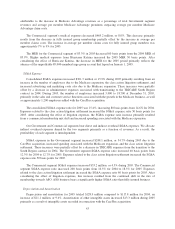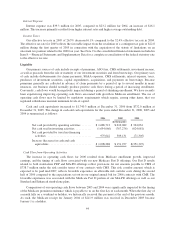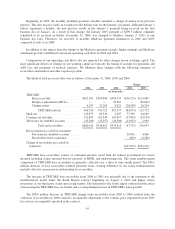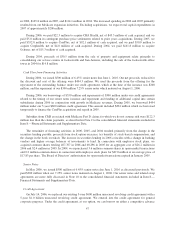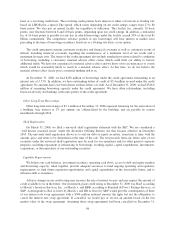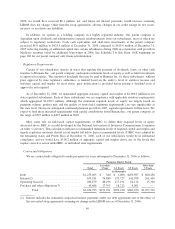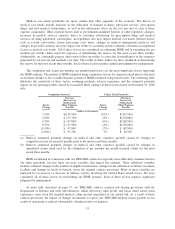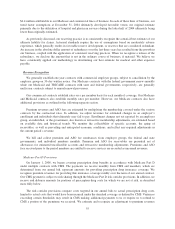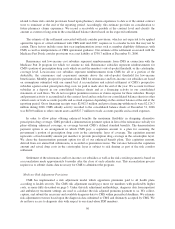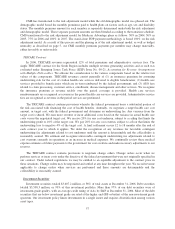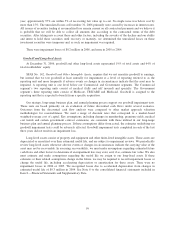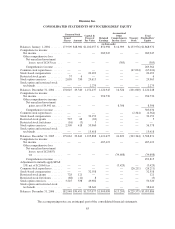Humana 2006 Annual Report Download - page 65
Download and view the complete annual report
Please find page 65 of the 2006 Humana annual report below. You can navigate through the pages in the report by either clicking on the pages listed below, or by using the keyword search tool below to find specific information within the annual report.
Medical cost trends potentially are more volatile than other segments of the economy. The drivers of
medical cost trends include increases in the utilization of hospital facilities, physician services, prescription
drugs, and new medical technologies, as well as the inflationary effect on the cost per unit of each of these
expense components. Other external factors such as government-mandated benefits or other regulatory changes,
increases in medical services capacity, direct to consumer advertising for prescription drugs and medical
services, an aging population, catastrophes, and epidemics also may impact medical cost trends. Internal factors
such as system conversions, claims processing cycle times, changes in medical management practices and
changes in provider contracts also may impact our ability to accurately predict estimates of historical completion
factors or medical cost trends. All of these factors are considered in estimating IBNR and in estimating the per
member per month claims trend for purposes of determining the reserve for the most recent three months.
Additionally, we continually prepare and review follow-up studies to assess the reasonableness of the estimates
generated by our process and methods over time. The results of these studies are also considered in determining
the reserve for the most recent three months. Each of these factors requires significant judgment by management.
The completion and claims per member per month trend factors are the most significant factors impacting
the IBNR estimate. The portion of IBNR estimated using completion factors for claims incurred prior to the most
recent three months is less variable than the portion of IBNR estimated using trend factors. The following table
illustrates the sensitivity of these factors assuming moderate adverse experience and the estimated potential
impact on our operating results caused by reasonably likely changes in these factors based on December 31, 2006
data:
Completion Factor(a): Claims Trend Factor(b):
Factor
Change
Increase
(Decrease) in
Medical and
Other Expenses
Payable
Factor
Change
(Decrease)
Increase in
Medical and
Other Expenses
Payable
(dollars in thousands)
1.50% $(143,500) (10%) $(347,500)
1.00% $ (95,700) (8%) $(278,000)
0.50% $ (47,800) (6%) $(208,500)
0.25% $ (23,900) (4%) $(139,000)
(0.50%) $ 47,800 (2%) $ (69,500)
(1.00%) $ 95,700 2% $ 69,500
(a) Reflects estimated potential changes in medical and other expenses payable caused by changes in
completion factors for incurred months prior to the most recent three months.
(b) Reflects estimated potential changes in medical and other expenses payable caused by changes in
annualized claims trend used for the estimation of per member per month incurred claims for the most
recent three months.
IBNR established in connection with our TRICARE contracts is typically more difficult to estimate than for
our other operations, because there are more variables that impact the estimate. These additional variables
include continual changes in the number of eligible beneficiaries, changes in the utilization of military treatment
facilities and changes in levels of benefits versus the original contract provisions. Many of these variables are
impacted by an increase or decrease in military activity involving the United States armed forces. We have
considered all of these factors in establishing our IBNR estimate. Each of these factors requires significant
judgment by management.
As more fully described on page 57, our TRICARE contract contains risk-sharing provisions with the
Department of Defense and with subcontractors, which effectively limit profits and losses when actual claim
experience varies from the targeted medical claim amount negotiated in our annual bid. As a result of these
contract provisions, the impact of changes in estimates for prior year TRICARE medical claims payable on our
results of operations is reduced substantially, whether positive or negative.
53


